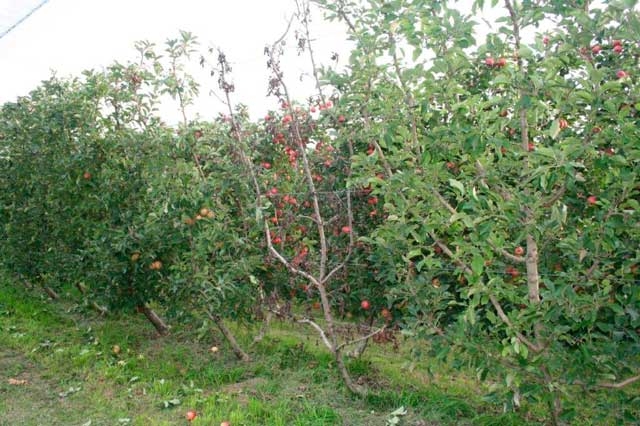Collar rot and crown rot of apple trees, and trunk rot of stone-fruit trees (but rarely pear trees) are caused by the fungus Phytophthora.
They are among the most serious soil-borne diseases in the world.
Diseased trees are mostly found where soil type, topography, climate, and/or irrigation have contributed to long periods of saturated soil.
Phytophthora comes from the Greek for ‘plant destroyer’. Although there are several species of Phytophthora that attack the roots of many ornamental, fruit and forest trees, mainly two species of Phytophthora attack deciduous fruit trees.
Phytophthora cactorum rots the roots and trunks of apple trees, and Phytophthora cinnamomi rots the roots and trunks of stone-fruit and avocado trees.
Water mould fungi
Phytophthora species are often referred to as water mould fungi because they need free water to spread in soil and to infect orchards and nursery trees.
Although these fungal species may vary somewhat in their temperature needs, their tendency to attack root versus crown tissue, or their aggressiveness against different rootstocks, all Phytophthora species have two important characteristics in common: they thrive in wet soil and they need free water to spread and cause significant disease.
Reproduction, spread and infection
Reproduction, spread and infection of trees by these fungi increase in saturated soil.
The pathogens can also move in contaminated soil on equipment, boots and vehicles; plant material; and in water (irrigation and run-off).
In winter, and for up to 10 years, the fungus survives as thick-walled resting spores (oospores) in the soil and rotted roots.
In spring, the oospores germinate in wet, warm soil and form sac-like sporangia which release many mobile zoospores into the soil water.
The zoospores are attracted to tree roots and then infect the roots. The longer and more often the soil is wet, the more likely the zoospores will reach, infect and kill vigorous and weak trees alike.
Young trees usually decline faster than mature trees between the wet periods.
In the southern hemisphere, Phytophthora cactorum is active from October to May in wet or saturated soil at 18C to 20C, and rootstocks are most susceptible from August to December.
So if growers detect Phytophthora in their fruit trees, the growers should actively eliminate the disease from October to December.
Roots need to breathe, rather as we do, in a process called respiration, that is, the roots take in oxygen, and release carbon dioxide.
Oxygen usually enters the soil in air from above, and carbon dioxide moves out of the soil to the air above. If this flow of gasses slows down or stops, e.g. in a soil that is saturated or slowly draining, toxic carbon dioxide builds up around the roots.
We cannot see this, but the drowning roots are now prime targets for the Phytophthora that loves the saturated soil with plenty of food, (i.e. dying roots) for the fungus.
It is often only when the trees try to grow in spring that we can see the damage. The roots cannot take up the water or nutrients needed for fast growth in spring. Ironically, the trees die from thirst, but the damage is due to drowned roots.
Collar rot and crown rot of apple trees
Phytophthora is among the most common cause of collar and crown rots of apple trees.
The fungus rots the trunk at ground-level (collar rot) or it rots the main roots where they join the trunk (crown rot)
You can first see the disease in spring, when the trees are growing poorly, buds are developing slowly and leaves are chlorotic.
During hot weather, the water-stressed trees start to wilt. For collar and crown rots, the main symptoms appear when the bark is cut away. The margin between diseased and healthy tissue is sharply defined.
The diseased tissue has zones of marbled tan to dark brown. Dead and diseased wood smell unpleasant and sour, hence the name sour sap.
You can also see root rot when you dig up the soil around the base of the tree. The main and fibrous roots are dark brown and rotten.
Usually trees slowly decline over several seasons and eventually die. Less often, trees suddenly collapse and die, especially after a very wet autumn or spring.
Trunk rot of stone-fruit
Phytophthora trunk rot most often attacks peach and apricot trees, but sometimes also nectarine, plum and cherry trees. (Continued next month)
See this article in Tree Fruit Nov 2017




















